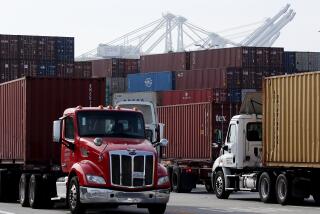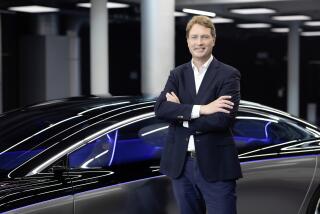Wait your turn
GENERALLY speaking, Californians are pretty lucky. We have Yosemite, we have Big Sur. Our state leads the nation in Anna Nicole baby-daddies.
And we have the California Air Resources Board, a bunch of bureaucratic do-gooders who actually do good when they’re not screwing up royally. Thanks to the air board, California (and four Northeastern states that just have to copy the cool kids, shuh) have adopted the EPA’s super-strict Tier II, Bin 5 emission standard two years before the rest of the country, which just adopted the less strict though still formidable Bin 8 standard. California has Bin there, done that.
Consequently, Californians will not be able to buy our test car, the 2007 Mercedes-Benz E320 Bluetec, the only legal diesel passenger car sold in the United States this model year, despite the fact that:
A) A Bin-8 compliant diesel is clean enough to eat (check out my bagel-in-the-tailpipe video on latimes.com/lawheels);
B) The Bluetec E-class gets 26 miles per gallon city/37 mpg highway, an astonishing 45% better fuel economy than the gas-powered E350, with commensurate reduction in greenhouse-gas emission; and
C) Affluent SoCal liberals would love to buy a fine German automobile that didn’t make them feel like a fine German war criminal.
For the moment, the E320 Bluetec clears only the 45-state standard, which is no small speed bump, to be sure. “Bluetec” actually refers to a suite of technologies that copes with inherent downsides of compression-ignition engines: that marbles-in-a-can clatter; the logy throttle response; the oily-sweet smell; the soot (particulates) and, most intractable, the emissions of NOx (oxides of nitrogen) generated by the hellish temperatures inside a diesel engine.
Like most current diesels worthy of the name, the E320 Bluetec uses a high-pressure common-rail fuel delivery system that, combined with advanced piezoelectric injectors, allows the engine computer to finely calibrate the fuel-air charge with respect to load and throttle demand.
All this pumping and spraying happens atop DaimlerChrysler’s corporate diesel V6, an all-aluminum DOHC engine dressed out with a variable-geometry turbocharger. With a redline of 4,600 rpm, the engine doesn’t produce significant horsepower (208 hp) but has torque like a nuclear attack sub: 388 pound-feet between 1,600 and 2,400 rpm.
If you’re old enough to remember the cantankerous, sooty exertions of a diesel engine of a decade or two ago, well, forget it. Squeeze the throttle of the E320 Bluetec and things start to happen sehr schnell: The turbo spools up, a rutting-warthog snarl fills the cabin and the car delivers a kick to your keister with crisp Prussian precision.
Zero-to-60 mph acceleration is in the mid-6 seconds, but it’s the passing power that leaves your tongue hanging out.
In the passing lane, this inoffensive burgher of the interstate pulls like a BMW M3. A multiplicity of transmission gears (seven-speed automatic is standard) keeps the car in the thrust-y thick of its power band. To keep the low-revving engine from running out of wind at high speed, the E320 Bluetec is fitted with a super-tall rear-gear ratio (2.65:1).
However, it’s the hardware downstream of the combustion chamber that makes Bluetec so clean, a series of catalysts and one very big particulate filter that scrub the exhaust of its nastiest components.
The big challenge is NOx. Bluetec uses a NOx Absorber Catalyst that holds some NOx in abeyance until combustion conditions are more favorable. The catalyst also releases NOx-neutralizing ammonia that builds up in the Selective Catalytic Reduction catalyst, which helps further reduce NOx. Bluetec has some very cool tricks: If the particulate filter starts filling up, the system will order the engine to operate at higher combustion temps, thereby burning off trapped particulates.
Obviously, the Bluetec system comprises some major-league chemistry and, in fact, the introduction of the system had to wait until ultra-low sulfur diesel fuel became widely available (sulfur plays havoc with diesel catalysts).
Not many NOx molecules make it past the Bluetec gantlet, but some do. To meet the higher standard, ’09 Bluetec-equipped cars will have an additional system: a reservoir of ammonia-rich urea, to be injected into the exhaust stream. The ammonia converts the NOx into nitrogen and water (4NO + 4NH3 + O2 reacts to become 4N2 + 6H2O, for the mad chemists among you). The AdBlue tank will get refilled during normal vehicle maintenance and those who ignore it will find that, eventually, their cars won’t start.
It’s all good news for pain-averse environmentalists. Some of Mercedes’ grossest grosserwagens -- like the R-class, GL-class and M-class cars -- will get vastly better fuel economy than their gas-powered siblings with no appreciable loss in performance as well as sparkling clean emissions. And not just Mercedes. In an unusual alliance among German carmakers, VW and Audi announced in November that they will also offer Bluetec-branded diesels.
I know what you’re thinking. Wow, if diesel can help this 2-ton luxury sedan to get 37 mpg on the highway (my results were more like 40 mpg on a single long trip), how about a diesel hybrid? Good question.
First, because electric motors and diesel engines both make torque at low rpm, combining them in a “parallel hybrid” architecture amounts to a duplication of effort. Second, both systems add price premiums over their gas-powered equivalent; however, the diesel “premium” on the E320 Bluetec is only about $1,400, as compared to the hybrid premium of over $8,000 on a Lexus GS450h (relative to the conventional GS350).
Then there are issues of packaging. However, in a “series hybrid” architecture, where the engine drives a generator (like the upcoming Chevy Volt), a diesel engine makes all grades of sense.
There’s one other problem with these big-displacement, high-tech diesels, and that is simply they are not as efficient as smaller diesels. I’m afraid that the availability of these thrifty powertrains will tempt consumers to continue to buy enormous vehicles, thereby negating some of the big-picture benefits.
A diesel-powered tank is not a step in the right direction, and people should weigh their transportation needs accordingly. Even if all the promises of biodiesel advocates come true -- and there’s reason to be skeptical -- diesels don’t solve the problem of energy consumption and greenhouse emissions. They only forestall the reckoning.
*
*
(BEGIN TEXT OF INFOBOX)
2007 Mercedes-Benz E320 Bluetec
Base price: $52,325
Price, as tested: $59,375
Powertrain: Turbocharged diesel 3.0-liter 24-valve DOHC V6; seven-speed automatic transmission with adaptive shift logic; rear-wheel drive.
Horsepower: 208 at 3,800 rpm
Torque: 388 pound-feet at 1,600-2,400 rpm
Curb weight: 3,860 pounds
0-60 mph: 6.5 seconds
Wheelbase: 112.4 inches
Overall length: 191.0 inches
EPA fuel economy: 26 miles per gallon city/37 mpg highway
Final thoughts: Dieselicious






